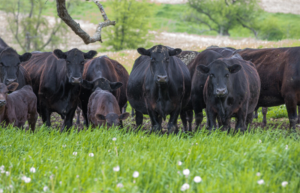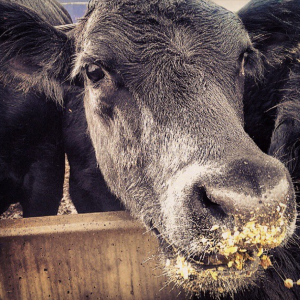I have heard many rumours about livestock nutrition and wanted to set the record straight. Yes, cattle can, and do, happily eat grain like corn and soybean meal! No, they aren’t fed old, expired grains. No, GMOs don’t make livestock sick. Is your head spinning yet? I know mine is, but there isn’t an ounce of truth to these rumours. (You know, since it’s on the internet it must be true!)
On our farm, our beef cows are on grass pasture year round and used for breeding purposes only. Technically speaking, a “cow” is a female that has had a calf. There are also steers, bulls, and heifers. Once the cows have had calves, they stay with mom until they are weaned at 6 to 8 months and are moved to our pens and feedlots where they are grain finished until they are market ready. Grass keeps them lean while grains help them gain. Kinda like with humans, you would gain a lot more weight on a 24/7 pizza buffet than you would at the salad bar.

I use this comparison, but the reality is that our digestive system is quite different to that of a ruminant. To help everyone understand this, I did a Q&A with my good friend Kim Bremmer, founder of Ag Inspirations. Kim has a similar mission as myself, to connect people to how their food is produced. Before she started Ag Inspirations, she spent 15 years as an on-farm ruminant nutrition consultant and holds degrees in Agricultural Journalism and Dairy Science from the University of Wisconsin-Madison. Needless to say, she really knows her stuff. Here are a few questions I asked her, to help us clarify some common misconceptions:
Michelle Miller: What is a ruminant?
Kim Bremmer: Ruminants are mammals that have four compartments to their stomachs; a rumen, reticulum, omasum, and abomasum. Cattle are ruminants. They eat their food, it partially ferments, and they regurgitate it to be chewed again to break down all the plant material. The word ruminant comes from the Latin ruminare, which means “to chew over again.” There are approximately 150 species of ruminants, including both wild and domestic species.
MM: What makes them unique?
KB: The science of ruminant nutrition is fascinating! Ruminants are able to digest fiber from plants that humans cannot, and turn fiber into food that we can consume. It is an intricate process involving fermentation by rumen microbes.
MM: Some people think that cattle shouldn’t eat corn, that they should only eat grass. What are your thoughts on this?
KB: We know there is a lot of misinformation about farming in the discussion about food today as companies try to differentiate themselves and capture margin in the market place. The real story of agriculture gets lost in marketing campaigns. Technically speaking, corn is a grass. We formulate diets for cattle based on what a farmer grows on their individual farm. No two farms are the same, and there is no one-way, one-size-fits-all-way to farm. We balance the diets for cows every day for over 60 different nutrients, right down to specific amino acids. Corn can be beneficial and used as a feed for livestock in many forms. When harvested as silage, it’s a source of fiber and starch. In the form of grain, it’s a source of energy for the rumen microbes, which is beneficial in fermentation. There are also a lot of by-products of corn that our cattle can use for sources of nutrients. When the majority of starch is removed in the process of making corn syrup, the remaining product is corn gluten feed — a source of protein and digestible fiber. In the process of making ethanol, the remaining product is distiller’s grains — a source of protein and energy. Everything in cattle diets today is about balance. Corn is not harmful to cattle.

MM: How often do livestock get fed antibiotics?
KB: Antibiotics are occasionally fed to animals for the treatment or control of various diseases. They are an added expense. At a time when farmers receive just over 17 cents of every dollar spent on food, margins at the farm level are small and every on-farm expense is scrutinized. The focus on farms today is about preventing disease. Farmers use fewer shared class antibiotics on livestock, and everything is about continual improvements. Farmers and ranchers work closely with their veterinarians to establish overall herd health programs and effective on-farm treatment protocols in the event of an illness. If an animal is given antibiotics, it cannot enter the food supply until the antibiotics are no longer present. The food safety protocols in our country are impressive … every animal that is harvested for food in our country is inspected.
MM: Some people hear that livestock get fed cheap or moldy grain. Where do they come up with this stuff?
KB: We wouldn’t want to feed moldy grain to animals. Molds, yeasts, and toxins all can cause health problems. Healthy animals are the No. 1 priority on farms and ranches.
MM: Is it true that livestock graze on areas of land not suited for crop production?
KB: Yes! Actually 85 percent of all the graze lands in the United States are not suitable for growing anything except the brushy type grasses and plants that currently grow there, plant material ruminants can digest and convert to food for us.
MM: What else would you like people to know about livestock nutrition?
KB: I wish more people realized how our nation’s livestock eat better than we do! The amount of research that continues to look at improvements in ruminant nutrition is astounding. So much has changed and improved in how we feed cattle. Healthy animals make healthy food!
MM: For further reading, what are some other good resources for people to learn more?
KB: Nutrient Requirements of Beef Cattle, National Research Council; Nutrient Requirements of Dairy Cattle, National Research Council; the FDA



